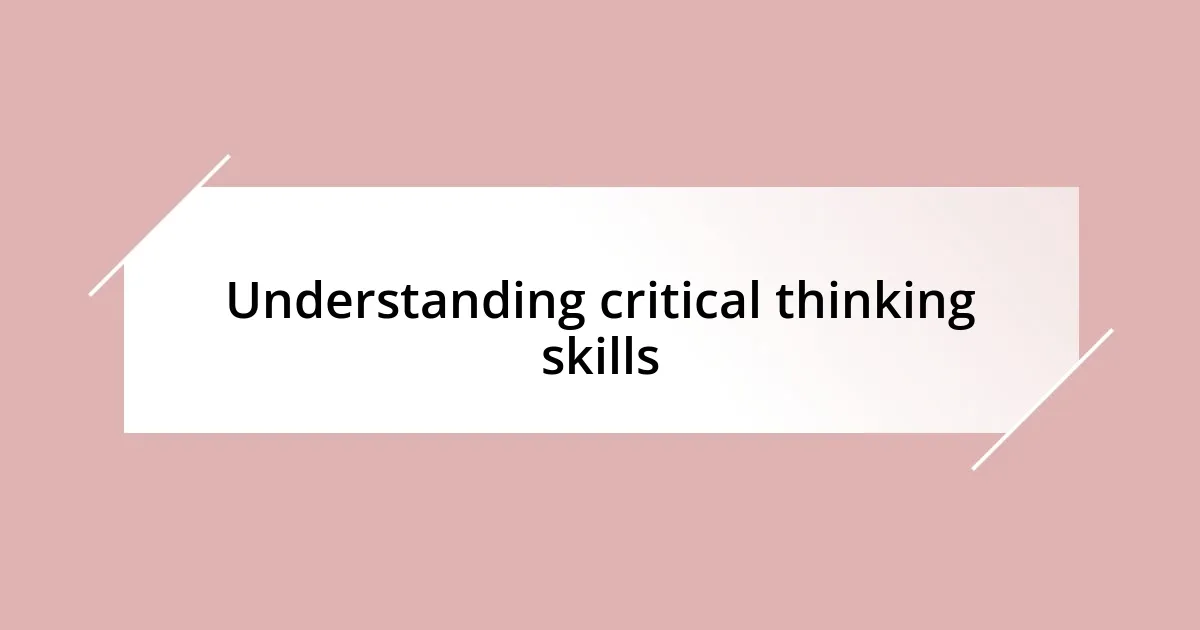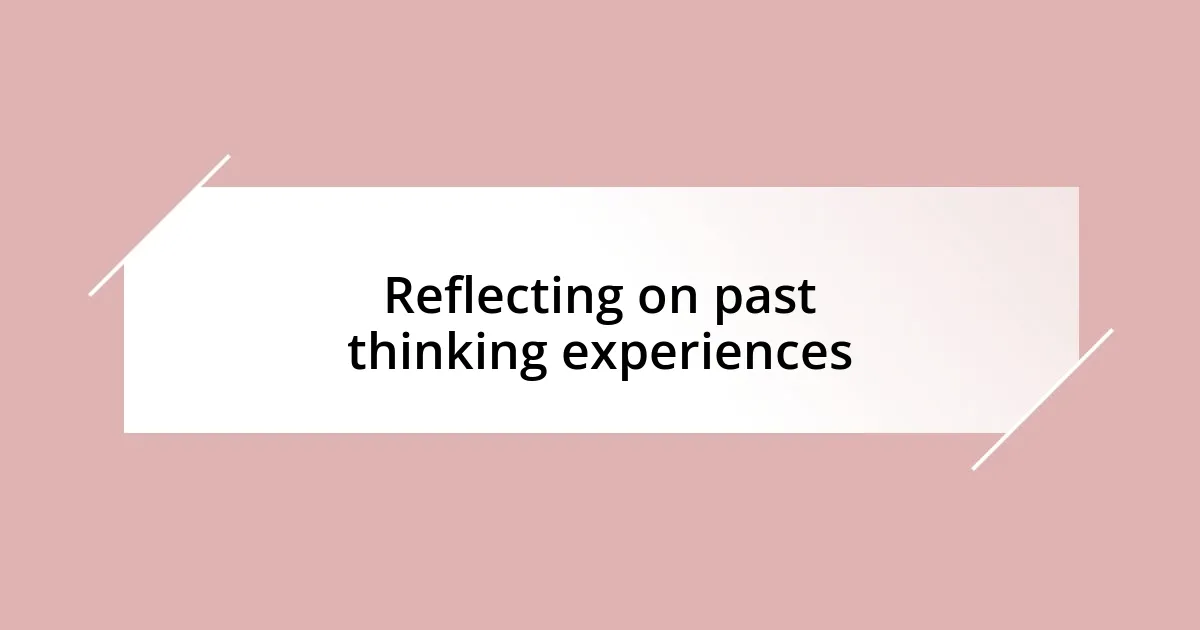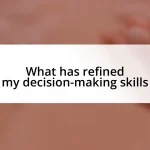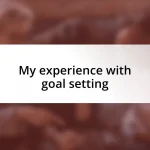Key takeaways:
- Critical thinking involves analysis, evaluation, and inference; it’s essential to question information rather than accept it at face value.
- Identifying personal thinking barriers, such as confirmation bias and self-doubt, is crucial for improving critical thinking skills.
- Practicing effective questioning techniques, including the Socratic method and active listening, enhances understanding and encourages diverse perspectives.
- Continuing education and embracing intellectual humility lead to ongoing growth in critical thinking, allowing for shifts in perspective and deeper insights.

Understanding critical thinking skills
Critical thinking skills are the tools we use to evaluate information and make reasoned decisions. I remember a time when I faced a dilemma at work; a colleague presented data that didn’t add up. Instead of taking it at face value, I decided to dig deeper. Isn’t it fascinating how a basic questioning mindset can lead to uncovering the truth?
To truly understand critical thinking, we must appreciate its components: analysis, evaluation, and inference. One day, I found myself pondering a news article that seemed sensationalized. By breaking down the arguments and assessing the evidence, I was able to view the story from multiple perspectives. Have you ever wondered how often we accept information without questioning its validity?
Moreover, mastering critical thinking means embracing the discomfort that comes with it. In a heated discussion with friends, I felt my emotions rising as differing opinions emerged. Instead of reacting impulsively, I took a moment to listen and reflect. What if more conversations started this way—prioritizing understanding over being right?

Identifying personal thinking barriers
Identifying personal thinking barriers can be a revealing journey. I once realized that my strong opinions often blinded me to alternative perspectives. This was evident during a team meeting when I was so invested in my viewpoint that I failed to fully consider my colleagues’ insightful contributions. Have you ever found yourself in a situation where you were so absorbed in your thoughts that you missed valuable input from others?
Another barrier I’ve encountered is that of self-doubt. There was a moment during a difficult project when I second-guessed my analytical skills. I remember struggling to voice my ideas, fearing they would be dismissed. This hesitance not only stifled my own creativity but also hindered collaboration. It’s interesting how our internal narratives can shape our ability to think critically.
Recognizing these barriers is the first step toward overcoming them. Sometimes, I reflect on my past experiences when I felt stuck, realizing that my mindset was the primary roadblock—much like being trapped in a fog. By actively questioning my beliefs and welcoming discomfort, I began to break through these barriers. How do you consciously approach your own thinking obstacles?
| Type of Barrier | Description |
|---|---|
| Confirmation Bias | Tendency to favor information that confirms existing beliefs. |
| Emotional Influence | Letting emotions guide rational thinking, leading to impulsive conclusions. |
| Overconfidence | Believing one knows enough, reducing the motivation to seek further evidence. |

Practicing questioning techniques effectively
Practicing effective questioning techniques is a transformative practice that can significantly enhance our critical thinking skills. I remember attending a workshop where we were encouraged to ask “why” repeatedly—this approach unveiled deeper insights I had never considered before. It was like peeling the layers off an onion, each layer revealing something valuable beneath. Have you ever tried to explore a simple question and found it led you to profound realizations?
To sharpen your questioning techniques, consider these strategies:
- Use Open-Ended Questions: Instead of asking questions that can be answered with a simple “yes” or “no,” aim for open-ended inquiries that prompt discussion. For instance, “What are the implications of this decision?” invites a richer dialogue.
- Practice Active Listening: Engaging fully with the responses you receive can sharpen your follow-up questions, leading to even deeper discussions. I often find that the answers reveal unexpected avenues.
- Stay Curious: Embrace a mindset of curiosity rather than judgment. When I began approaching conversations with genuine interest, I noticed people were more willing to share their insights.
By integrating these techniques regularly, you will not only enhance your own critical thinking but encourage a culture of inquiry in your interactions.
When I think about questioning techniques, I can’t help but recall a moment with a mentor. I asked a seemingly straightforward question about project management, and instead of providing a quick answer, he turned it back to me. “What do you think?” he asked, prompting me to articulate my thoughts. That experience was a revelation; it encouraged me to refine my ideas and build confidence in my reasoning. Have you experienced moments where a simple question made you reflect more deeply?
Here are some effective techniques to practice questioning:
- Socratic Method: Emulating this method involves asking a series of probing questions that challenge assumptions and foster critical dialogue. It can deepen your understanding of any topic.
- Reflective Questions: Incorporate questions that push for reflection, such as, “What evidence supports my viewpoint?” This not only clarifies your thoughts but also exposes gaps in reasoning.
- Encourage Diverse Perspectives: Invite differing opinions, keeping in mind that diverse viewpoints enhance critical thinking. In group settings, I always encourage quieter members to share their thoughts, as they often bring fresh perspectives.
Recognizing the power of questioning techniques is essential in cultivating a more profound critical thinking practice. Each question can serve as a stepping stone to greater understanding.

Evaluating information sources critically
Evaluating information sources critically is a skill that has grown increasingly important in our information-saturated world. I remember a time when I stumbled upon an eye-catching article claiming groundbreaking medical research. At first glance, it seemed credible, but a quick check of the author’s qualifications revealed a lack of proper expertise. Have you ever taken a moment to dig deeper into the sources behind the claims you encounter? I’ve learned that taking the time to scrutinize the source can save you from accepting misleading information as fact.
Asking specific questions is another crucial step I recommend. For example, consider the purpose behind the information: Is it meant to inform, persuade, or entertain? I once came across a viral social media post filled with statistics. It turned out the data was cherry-picked to support a particular agenda. Learning to distinguish between objective reporting and biased content has been eye-opening. Have you found yourself questioning the intent behind the information you consume? It’s a habit that can empower you to make informed decisions.
Lastly, don’t shy away from cross-referencing multiple sources. I’ve had moments where I felt convinced by one article only to discover stark contradictions in different publications. This pursuit of diverse perspectives has taught me that complexity often lies beneath the surface. Are we willing to engage with opposing views? By evaluating information sources critically, we ensure that our understanding is grounded in a well-rounded context rather than one-dimensional narratives.

Reflecting on past thinking experiences
Reflecting on my past thinking experiences often brings me back to a group project in college. I initially approached it with a fixed mindset, believing I had all the answers figured out. However, as we began discussing our ideas, I realized how easily I could overlook valuable perspectives. That shift in thinking taught me to embrace collaboration as a tool for enriching my understanding—has there been a time when collaboration led you to unexpectedly brilliant insights?
One particularly pivotal experience involved a mentor guiding me through a challenging dilemma. I vividly remember wrestling with a decision about my career path; it felt overwhelming. Instead of telling me what to do, she encouraged me to write down my thoughts and feelings. This reflective process turned out to be cathartic. It wasn’t just about finding the right answer; it was about understanding my motivations. Have you ever found clarity through reflection instead of seeking quick solutions?
As I think back, I can identify moments when embracing confusion became a powerful catalyst for growth. I recall facing a complex problem during a team meeting and feeling the instinct to have a “quick fix” response. Instead, I paused, allowing the silence to encourage more dialogue. This hesitation led to a collective exploration of ideas, revealing angles we hadn’t considered before. How often do we rush to conclusions without allowing space for deeper inquiry? The rewards of reflecting on past thinking moments truly illuminate how far we can go when we invite curiosity into our thought processes.

Continuing growth in critical thinking
As I think about my journey in critical thinking, I realize that I’ve continuously sought opportunities to challenge my beliefs and assumptions. One instance that stands out is when I volunteered at a community organization. Participating in open discussions about diverse social issues exposed me to perspectives I had never considered before. What about you? Have you explored different viewpoints in your everyday interactions? Engaging in such dialogues has been instrumental in broadening my understanding and refining my ability to think critically.
I find that ongoing education plays a significant role in my development. For instance, I enrolled in a workshop focused on cognitive biases—the mental shortcuts that can lead us astray. It was fascinating to learn about these biases through interactive exercises. I still remember recognizing a bias I often fall prey to: confirmation bias, where I tend to favor information that aligns with my existing beliefs. Have you identified any biases in your thinking? Acknowledging these pitfalls enables me to become more diligent in my critical assessment.
Lastly, I’ve learned the importance of intellectual humility in my critical thinking growth. It’s humbling to admit when I don’t know something, isn’t it? On one occasion, during a heated discussion about environmental policies, I felt compelled to defend my view passionately. However, I took a step back, realizing that listening more than speaking could offer richer insights. This moment reminded me that growth often comes from being open to change. Have you ever experienced a shift in perspective that challenged your original stance? Embracing such moments has become a cornerstone of my ongoing journey in critical thinking.












